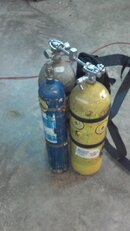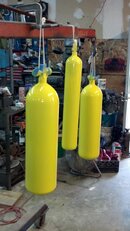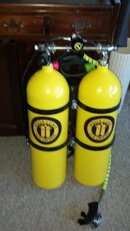You are using an out of date browser. It may not display this or other websites correctly.
You should upgrade or use an alternative browser.
You should upgrade or use an alternative browser.
Painting Tanks?
- Thread starter DennisC
- Start date
Please register or login
Welcome to ScubaBoard, the world's largest scuba diving community. Registration is not required to read the forums, but we encourage you to join. Joining has its benefits and enables you to participate in the discussions.
Benefits of registering include
- Ability to post and comment on topics and discussions.
- A Free photo gallery to share your dive photos with the world.
- You can make this box go away
Possible, yes.
If aluminum and you plan to use them and enjoy them it's futile.
If non glavanized steel it's still futile but important for preservation. You can begin and end with a cold galvanize finish and go camo.
Pete
If aluminum and you plan to use them and enjoy them it's futile.
If non glavanized steel it's still futile but important for preservation. You can begin and end with a cold galvanize finish and go camo.
Pete
LeadTurn_SD
Contributor
Hey so this is a weird question but is it possibly to repaint a tank? if so what do I need to do first and is there a special paint I should use?
When I was 18 (1976), I thought it would be a great idea to paint my galvanized steel '72 with high gloss black paint.
It looked wonderful for, oh, several dives, but much of the paint eventually scraped / wore off. I still use that tank, and can still see that it was painted black at one point.... but like Pete mentioned, the tank now looks like a mottled, galvanized grey / black camo.... actually gives it "character"
I imagine folks who are real-life painters / auto body guys will have some better suggestions.
Best wishes.
Bob DBF
Contributor
I repainted a steel tank back in the '80's and it has held up pretty well, I was told at the time by an old hand to do meticulous prep and use a two part epoxy paint. I was a PITA but if I had to, I'd do it again 'cause it worked.
Bob
Bob
oldschoolto
Contributor
Eric Sedletzky
Contributor
I've been in the auto body repair business since 1979 both metal man and painter. I have my own marine repair business now doing fberglass/gel coat, Awl Grip polyurethane, epoxy systems, primers, catylized zinc rich primers, all the industrial products not available to the general public. I've sprayed cars, pick ups, big rigs, trailers, boats, aircraft parts, etc. so I think I'm qualified to answer your question.
Unless you already have several hundred (or thousand) dollars worth of spray equipment, air compressor, D/A sander, several grits of commercial grade abrasives (not the crap from home depot) and are willing to spend probably equal to maybe a touch more on materials than what the tank is worth I would do this:
Clean it up the best you can with a wire brush (if rusty) and scuff pad. Sand out any surface rust coming through galvanizing with 220 grit sandpaper. Paint it with a zinc rich brushable coating like what they use on outdoor steel as a quick and dirty answer to keep it from rusting. With all my tools, equipment, extra polyurethane paint laying around from jobs past, I still prefer just to do it this way.
You can find the zinc coating at any welding supply store. It's about $50 for a quart can but it will last a long time and you could do dozens of tanks with one can. The product should be at least 80% zinc dust suspended in a resin vehicle like a solvent based acrylic polymer.
Zinc is a sacrificial metal so even if you get a scratch and a bit comes off exposing a little bare steel, the metal will actually "heal" itself in that spot due to the zinc pulling away any corrosive action caused by electrolosis by taking the hit, so to speak.
With polyurethanes, (if a zinc coating is not put on the bare steel first), it will work, but in the event there is a pinhole or a chip the rust will begin to grow under the tough coating and blister. Plain zinc on steel won't do that, it breathes but doesn't rust because the surface of the steel is held in dynamic suspension.
The only time you see it begin to rust is when the zinc begins to get thin and wear off, but the steel still does not blister and pit as a result, it just begins to turn a smooth reddish color which is telling.
Zinc and steel are a beautiful thing together.
If it's al aluminum tank, the only suggestion I have is to completely strip off any paint on the tank, sand the surface with 400 grit on an orbital sander, and polish it out with a 8" cotton edge buff wheel and bar rouge. I had a few like this and they lasted longer than any other aluminum tankl I ever had. All I had to do to maintain the shine was hit it with a little aluminum wheel polish every few months and it looked brand new. Leaving it open like that, the metal could breathe and as such never corroded. Plus the high shine and slick surface didn't allow any salt to penetrate the surface of the aluminum, so it would just bead off, dry, and that was it. The only thing that would tarnish the aluminum was a chlorinated pool. The ocean never screwed up my polish tanks.
Unless you already have several hundred (or thousand) dollars worth of spray equipment, air compressor, D/A sander, several grits of commercial grade abrasives (not the crap from home depot) and are willing to spend probably equal to maybe a touch more on materials than what the tank is worth I would do this:
Clean it up the best you can with a wire brush (if rusty) and scuff pad. Sand out any surface rust coming through galvanizing with 220 grit sandpaper. Paint it with a zinc rich brushable coating like what they use on outdoor steel as a quick and dirty answer to keep it from rusting. With all my tools, equipment, extra polyurethane paint laying around from jobs past, I still prefer just to do it this way.
You can find the zinc coating at any welding supply store. It's about $50 for a quart can but it will last a long time and you could do dozens of tanks with one can. The product should be at least 80% zinc dust suspended in a resin vehicle like a solvent based acrylic polymer.
Zinc is a sacrificial metal so even if you get a scratch and a bit comes off exposing a little bare steel, the metal will actually "heal" itself in that spot due to the zinc pulling away any corrosive action caused by electrolosis by taking the hit, so to speak.
With polyurethanes, (if a zinc coating is not put on the bare steel first), it will work, but in the event there is a pinhole or a chip the rust will begin to grow under the tough coating and blister. Plain zinc on steel won't do that, it breathes but doesn't rust because the surface of the steel is held in dynamic suspension.
The only time you see it begin to rust is when the zinc begins to get thin and wear off, but the steel still does not blister and pit as a result, it just begins to turn a smooth reddish color which is telling.
Zinc and steel are a beautiful thing together.
If it's al aluminum tank, the only suggestion I have is to completely strip off any paint on the tank, sand the surface with 400 grit on an orbital sander, and polish it out with a 8" cotton edge buff wheel and bar rouge. I had a few like this and they lasted longer than any other aluminum tankl I ever had. All I had to do to maintain the shine was hit it with a little aluminum wheel polish every few months and it looked brand new. Leaving it open like that, the metal could breathe and as such never corroded. Plus the high shine and slick surface didn't allow any salt to penetrate the surface of the aluminum, so it would just bead off, dry, and that was it. The only thing that would tarnish the aluminum was a chlorinated pool. The ocean never screwed up my polish tanks.
Rich Keller
Contributor
I picked up a steel galvanized tank that someone painted over but not that well. What is the best way to remove the paint without disturbing the galvanized coating underneath?
oldschoolto
Contributor
Aircraft / Automotive chemical paint stripper.... Use a brush and then cover with plastic sheet and the paint will come off... You cover the stripper so it does not lose the VOC's... Once stripper drys it is no longer working...
Jim...
And Eric is right about the time it takes... Painting is 90% prep.... 10% spraying.... :shocked2:
Jim...
And Eric is right about the time it takes... Painting is 90% prep.... 10% spraying.... :shocked2:
Adventure-Ocean
Contributor
We had over 40 tanks that circulated daily for dives. We painted the top 20% to mark them as ours when we brought them to be filled. The quality of the paint job has to do with how much you want to put into it. Our tanks were aluminum so we'd use a quality primer for aluminum (zinc cromate). The final color coats can be regular enamel, acrylic enamel, or epoxy paints. Our biggest problems were tanks knocking into each other during transportation and chipping the paint. Have fun.... Adventure-Ocean
HungoverDiver
Contributor
If it's al aluminum tank, the only suggestion I have is to completely strip off any paint on the tank, sand the surface with 400 grit on an orbital sander, and polish it out with a 8" cotton edge buff wheel and bar rouge.
I know this is an oldish post, but does anyone have a protocol/suggestions for stripping the paint off an AL tank?
Similar threads
- Replies
- 5
- Views
- 470







